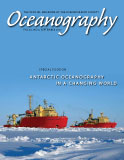Article Abstract
During recent decades, historically unprecedented changes have been observed in the Arctic as climate warming has increased precipitation, river discharge, and glacial as well as sea-ice melting. Additionally, shifts in the Arctic’s atmospheric pressure field have altered surface winds, ocean circulation, and freshwater storage in the Beaufort Gyre. These processes have resulted in variable patterns of freshwater export from the Arctic Ocean, including the emergence of great salinity anomalies propagating throughout the North Atlantic. Here, we link these variable patterns of freshwater export from the Arctic Ocean to the regime shifts observed in Northwest Atlantic shelf ecosystems. Specifically, we hypothesize that the corresponding salinity anomalies, both negative and positive, alter the timing and extent of water-column stratification, thereby impacting the production and seasonal cycles of phytoplankton, zooplankton, and higher-trophic-level consumers. Should this hypothesis hold up to critical evaluation, it has the potential to fundamentally alter our current understanding of the processes forcing the dynamics of Northwest Atlantic shelf ecosystems.

